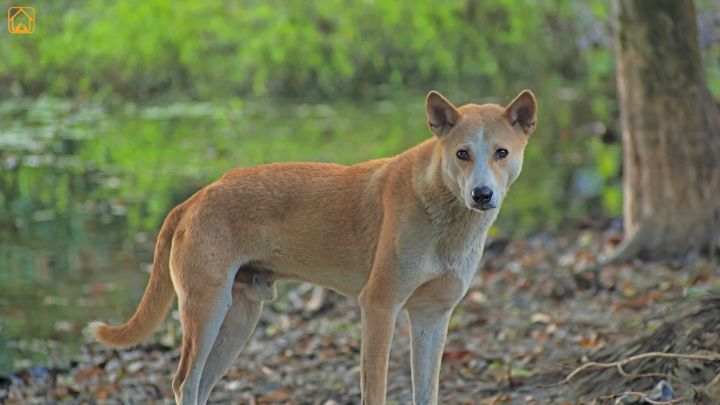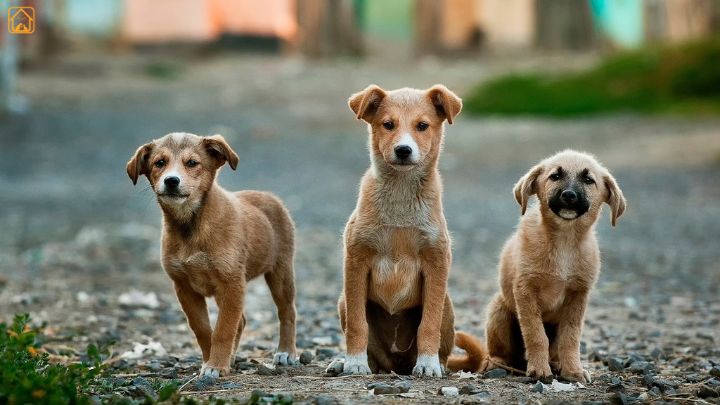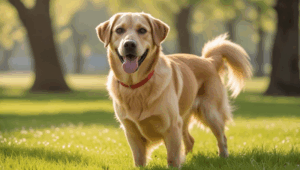Origins and History of the Indian Pariah Dog
The Indian Pariah Dog is one of the oldest dog breeds in the world. They’ve been living in India for more than 4,500 years. In fact, scientists found a dog skull in Mohenjo-daro, showing that these dogs lived during the time of the Indus Valley Civilization.
What makes them special is that they weren’t created by people through breeding. They developed naturally over time. They learned how to survive in different parts of India like hot cities, dry deserts, green forests, and cold hills without needing much help from humans.
Ancient Roots, Modern Resilience
The Indian Pariah Dog is known as a landrace breed. That means they were shaped by nature, not by dog breeders. Some old cave paintings even show these dogs walking next to early humans, which proves how long they’ve been part of our lives.
They have helped people for many generations. In villages and towns, they’ve been trusted as guard dogs, helpers in hunting, and loyal companions. These dogs are smart, alert, and full of energy. They are also very healthy and don’t get sick as easily as some foreign breeds.
Here’s the strange part, these dogs are everywhere in India, but many people still choose foreign breeds instead. That’s sad because the Indian Pariah Dog is strong, friendly, easy to care for, and perfectly suited for Indian weather and lifestyle.
They are not street mutts or mixed breeds. They are a pure, natural breed with a rich history and a strong future.
Physical Characteristics and Breed Standards

The Indian pariah dog is easily recognized on the streets of India. They’re medium-sized, with a square or slightly rectangular build and athletic frame. Their double coat is short and dense, a coarse top layer with a soft undercoat, making them well-suited to both scorching summers and cool winters.
Breed Appearance at a Glance
- Size: Male Indian Pariah Dogs typically weigh between 17 to 33 kg and stand about 19 to 24 inches tall. Females are smaller, weighing around 15 to 26 kg with a height of 16 to 23 inches.
- Coat Colors: Most Pariah Dogs are fawn, sandy, or reddish-brown. Some have white patches, black markings, or are pied (a mix of colors). Black ones are rare, but you might see them in certain parts of India.
- Head & Ears: Their head is shaped like a wedge, and their ears stand straight up, always ready to catch a sound. Their pointed muzzle helps them sniff things out easily.
- Eyes: Their dark brown eyes are almond-shaped and full of alertness. These dogs are always aware of what’s going on around them.
- Tail: Their tail curls up and stays high, especially when they’re happy or excited.
They’re often mistaken for mixed-breeds, but a pure Indian pariah dog has a consistent look. If you’ve ever seen one race across a field, you’ll know, they move with a wild, effortless grace that’s hard to miss.
Temperament and Behavior: What Makes Indian Pariah Dogs Unique
Indian Pariah Dogs are known for being smart, alert, and quick to learn nature. Because they’ve had to survive on their own for generations, they’ve developed strong instincts. They can find food, avoid danger, and read people very well—all without being trained.
But don’t let their independence fool you. Once they trust someone, they become deeply loyal. I’ve seen an Indie become part of a family in just a few days. They pick up on your mood, know when something feels off, and will quietly watch over the house without needing constant attention.
Social, Loyal, and Alert
- Loyalty: Indian Pariah Dogs are known for their loyalty. Once they bond with their family, they stick with them for life. They build strong connections and are always looking out for the people they love.
- Socialization: They’re naturally alert and social, but they may be a little shy or cautious around strangers at first. That’s why early socialization like meeting new people, pets, and places is important. With the right start, they get along great with kids and other animals.
- Watchdog Instincts: One thing that stands out is their watchdog instinct. They’re quick to notice strange sounds or new faces, and they won’t hesitate to bark if something feels off. They’re not aggressive, they’re just protective.
- Independence: Pariah dogs also have an independent side. They enjoy your company, but they’re okay being alone for a while. This comes from generations of figuring things out on their own.
Some people wrongly think these dogs are aggressive. The truth is, with love, patience, and gentle training, Indian Pariah Dogs are some of the kindest, smartest dogs you’ll ever meet. They pick up commands quickly and respond best to positive reinforcement praise, treats, and kind words go a long way. If you’re raising a young one, check out our Puppy Training guide to start them off on the right paw.
Lifespan, Health, and Common Medical Issues
One of the best things about the Indian Pariah Dog is how healthy and strong they are. Unlike many modern breeds that suffer from health problems due to overbreeding, Pariah dogs have survived for thousands of years through natural selection. That means only the strongest and healthiest dogs passed on their traits. Because of this, most Indian Pariah Dogs live long lives, usually between 11 to 15 years, and sometimes even longer with good care.
Pariah dogs are genetically strong. They are less likely to suffer from many of the inherited diseases seen in popular purebred dogs. You won’t often hear of them having hip problems, heart conditions, or breathing issues that are common in some other breeds.
Common Health Issues
Even though they’re tough, they still need care. The most common health issues are skin infections, tick or flea infestations, and ear infections, mostly caused by outdoor exposure and not by genetics. Regular grooming and routine vet checkups can prevent these problems or catch them early.
Also, just like any dog, vaccinations are a must. Make sure they’re protected against rabies, parvo, distemper, and other serious illnesses. Regular deworming and parasite control also keep them safe and healthy.
They also adapt well to Indian weather. Whether it’s hot summers, monsoons, or chilly winters, they handle it all better than most foreign breeds. Their short, double coats keep them comfortable year-round.
Diet & Nutrition: Best Food for Indian Pariah Dogs
Indian Pariah Dogs are not fussy eaters, but that doesn’t mean they should eat just anything. In the wild or on the streets, they often survive on food scraps. But if you’re raising one as a family pet, they deserve a proper, balanced diet.
Best food for Indian pariah Dog
The best food for Indian Pariah Dogs is a mix of high-quality commercial dog food made for medium-sized breeds and fresh, home-cooked add-ons. You can safely feed them boiled chicken, plain rice, cooked carrots, green beans, and eggs. These foods are gentle on the stomach and full of nutrients.
Feeding Tips and Portion Control
Avoid feeding them spicy, salty, or oily foods. Many human snacks, like chips or sweets, can upset their digestion and even cause long-term health issues. Also, make sure they have clean drinking water available all day.
These dogs are naturally lean and active, so they don’t need large portions. Overfeeding or giving too many treats can lead to weight gain, especially if they’re kept indoors. Keep their meals simple and nutritious.
And here’s something funny, Pariah Dog puppies often ignore store-bought treats but go crazy for plain boiled chicken. Keep it natural, and they’ll be happy and healthy. For a full breakdown of safe ingredients, portion tips, and must-avoid foods, check out our Dog Nutrition Guide.
Care, Grooming, and Exercise Needs
Indian Pariah Dogs are one of the easiest breeds to care for. They’re built for the Indian climate and don’t need fancy grooming routines or expensive spa visits. Just some basic care, love, and playtime, they’ll stay happy and healthy.
Grooming Needs
Their short coat is naturally clean and doesn’t shed too much. Here’s what they need:
- Brushing: Once a week is enough to remove loose hair and keep their skin healthy.
- Bathing: Give them a bath once a month, or only when they get dirty.
- Nail Trimming: Trim their nails every few weeks if they don’t wear down naturally.
- Dental Care: Offer dental chews or brush their teeth once in a while to prevent tartar and bad breath.
Exercise & Activity
Pariah dogs are full of energy and love to explore. Make sure they get:
- Daily walks to stretch their legs and burn energy
- Playtime like fetch, tug, or running around. A secure yard or open space is a bonus.
- Mental stimulation, like sniffing games or learning simple tricks
One Indie I knew would chase a tennis ball for hours, then nap in the sun without a care in the world. They’re active but calm, a perfect match for most families.
Indian Pariah Dog vs. Other Breeds: Myths and Facts
There are plenty of myths about Indian pariah dogs, mostly unfair. Let’s clear them up:
- Myth: Indian Pariah Dogs are aggressive.
Truth: They’re not. With love and early socialization, they become calm, loyal, and very friendly. Most Indies are gentle by nature and make great family pets. - Myth: You can’t train them.
Truth: This is far from true. Indian Pariah Dogs are very smart and quick to learn. With positive training, like using treats, praise, and patience they pick up commands easily. - Myth: They only belong in villages or farms.
Truth: These dogs can adapt to city life, apartments, or houses as long as they get daily walks, exercise, and some space to move around. They don’t need much, just your time and care. - Myth: Indian street dog breeds are unhealthy.
Truth: Actually, they are one of the healthiest dog breeds in India. Their strong immune system comes from centuries of surviving tough conditions. With basic care, they live long, healthy lives.
Compared to many imported breeds, the Indian pariah is lower-maintenance, less prone to allergies, and more adaptable. The only thing they need is a chance to prove themselves as loving companions.
Adopting and Raising Indian Pariah Dog Puppies
Thinking of adopting an Indian street dog or raising an Indian pariah dog puppy? It’s a rewarding experience. Pariah puppies are curious, playful, and quick learners, but they need early socialization and gentle discipline.
Tips for New Pet Parents
- Adopt from a reputable shelter or rescue, avoid buying Indian pariah dogs, as plenty are waiting for loving homes.
- Prepare your home: puppy-proof spaces, set up a comfy bed, and have basic supplies ready.
- Start training early, using positive reinforcement like treats and praise.
- Regular vet check-ups, vaccinations, and deworming are vital for Indian pariah dog puppies.
- Give them time and patience, they may take a little longer to adjust if coming from the street.
I’ll never forget the first Indie puppy I fostered, shy at first, but within a month, her confidence blossomed. Now, she’s the boldest one at the dog park. These dogs just need a chance.
FAQs About Indian Pariah Dogs
What is the Indian pariah dog lifespan?
Indian pariah dogs typically live between 11 and 15 years, thanks to their robust health and genetic diversity. With good care, some live even longer.
Is the Indian pariah dog aggressive?
No, not inherently. With proper socialization and training, they’re friendly, loyal, and gentle. Like any breed, their behavior depends on upbringing and environment.
Can I buy an Indian pariah dog?
While some breeders may claim to sell ‘pure Indian pariah dogs,’ it’s more ethical to adopt from shelters. Thousands of Indian street dogs and pariah puppies are looking for loving homes.
What’s the difference between an Indian pariah dog and other Indian street dog breeds?
The Indian pariah dog is a distinct, ancient landrace breed. Many street dogs in urban areas have mixed ancestry, but pure Indian pariah dogs have specific characteristics and a recognized breed standard.
What’s the best food for Indian pariah dogs?
A balanced diet of commercial dog food (for medium breeds), lean meats, and cooked veggies works well. Avoid spicy or oily foods, and always provide fresh water.
Are Indian pariah dogs good with children and other pets?
Yes, when socialized early. They often form strong bonds with children and can get along with other pets, especially if introduced gradually.
How do I care for an Indian stray dog I’ve rescued?
Take them to a vet for a health check, vaccinations, and deworming. Provide a safe, comfortable space, nutritious food, and patient socialization. Consistency and love go a long way!
Conclusion
Choosing an Indian pariah dog isn’t just adopting a pet, it’s welcoming a piece of living history into your home. Their loyalty, adaptability, and health make them a truly special companion. If you’re ready for a friend who’ll stick by your side through thick and thin, your Indie is waiting.



